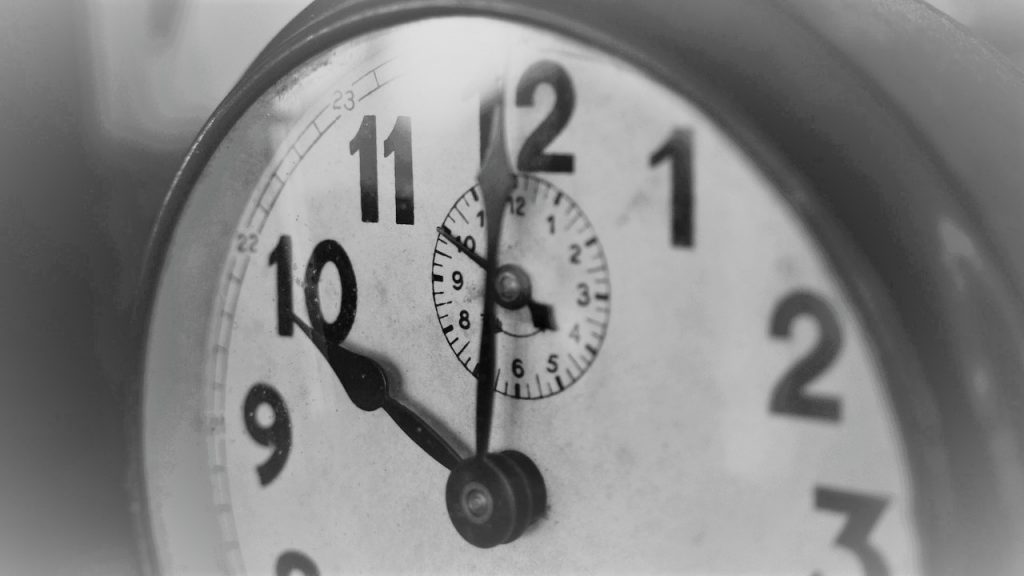Writing About Time in English Posted by Gary Locke on Sep 7, 2017 in English Grammar, English Language, English Vocabulary

I’m sure that you know how to tell time, but do you know all the ways that time can be written out on a page? What’s the preferred method? And what does GMT, and a.m. and p.m. mean, anyway?
Many years ago, I was a radio announcer. At least twice every hour that I was broadcasting I was required to announce the time. If it was 1:45 in the afternoon, I would tell my listeners, “It’s fifteen minutes in front of the hour of two o’clock! The afternoon is just spinning by. Now, before you spin that dial, let’s play some more music!”
Okay, it was a bit cheesy. However, it gave my listeners the exact time of day and segued into the next song. I once announced that it was 4 o’clock. Incredibly, in less than two minutes, someone called the station to ask if it was 4 a.m. or 4 p.m. Now, anyone looking out their window should be able to tell if it was 4 in the morning since it would be completely dark out at that hour. But, no. The station manager told me that I should never assume that my listeners can look out a window and that I always needed to let them know the exact time of day. Lesson learned.
You may have also noticed that there are numerous ways to announce the time. The examples I gave are just a few of many. And, as with so many things that Americans and Brits disagree on, English speakers make telling time confusing.
We use a 12-hour clock system in Britain and the U.S. for telling time, but some industries in Britain use the older, established 24-hour clock. You’ll hear the BBC use it. Midnight is 00:00 GMT. If it is 4 p.m. in the states, it would be 16:00 hours, GMT (Greenwich Mean Time). At least with that method, nobody would have to look out their window to tell if it was morning or afternoon!
GMT, a.m., and p.m.
Greenwich Mean Time was first established with the building of the British Royal Observatory in 1675, as an aid to mariners to determine longitude at sea, as well as providing a standard reference of time for all travelers. Time varies by four minutes for each geographical longitude beyond Greenwich, England. Time zones accumulate these differences, and then divides them into longer units of hours for convenience.
For those who prefer the 12-hour clock, and that now includes most of Britain and all the U.S., the hours are designated by a.m., from the Latin Ante meridiam or Before noon, and p.m., from the Latin Post meridiam or After noon. Adding to the confusion is the myriad ways you can write am and pm. Some style guides prefer capitalization (AM/PM), others will accept lower-case (am/pm), while some others insist on periods (a.m./p.m. or A.M./P.M.).
The argument is made that, in English, am is already a word. In radio, AM stands for amplitude modulation. Whereas a.m. is clearly an abbreviation. Why confuse things?
Incidentally, since a.m. stands for before noon, and p.m. stands for after noon, noon is neither a.m. nor p.m. Never write 12 p.m. or 12 a.m., because those times do not actually exist. There is noon and there is midnight.
It’s a Question of Taste
Style guides are tricky to follow. I have worked for companies which insist that all correspondence follow specific guidelines. I once even wrote the style guide for one of my employers. It was nice to have the power to decide which method of writing time I preferred.
The two most notable style guides in the United States are The Chicago Manual of Style, and the AP Style Guide, and they both prefer that time should be noted with the numeral, a colon, followed by the abbreviations in lower case letters and periods. Therefore, fifteen minutes before two in the afternoon should be written as 1:45 p.m. They do not agree on how to write even hours. AP would have you write one o’clock in the afternoon as 1 p.m., but Chicago would insist on 1:00 p.m. Which is proper? That’s up to you.
It is perfectly proper to write one o’clock (short for of the clock) in the afternoon instead of 1 p.m., but do you want to? You can write 1:45 p.m., or you could write a quarter to two in the afternoon, which means a quarter hour before two o’clock. These are all acceptable options. However, there is no practical reason for writing out the time in words if everyone understands what you mean with numbers. It is excessive.
I prefer to follow AP Style Guide, with what seems to be a practical methodology without any redundancy. But what is most important is consistency. However you choose to write time in English, always follow the same rule every time!
So, for my preferences, I get up at 6:30 a.m., fix breakfast by 7 a.m., arrive at work by 8:30 a.m., have lunch at noon, leave for the day at 5 p.m., and plan to be in bed well before midnight.

Build vocabulary, practice pronunciation, and more with Transparent Language Online. Available anytime, anywhere, on any device.




Comments:
Rene Adiao:
Which English is this article written in, American or British?
gary:
@Rene Adiao I would call this American English.